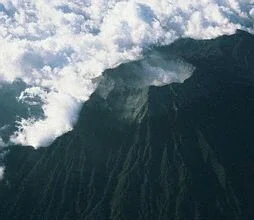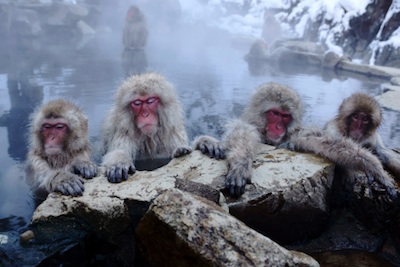Deep inside the Earth it is very hot.
Hot lava from inside the Earth comes out in volcanoes.
In some places, hot steam from inside the Earth shoots out.
In some places, there are pools of hot water.
We can use all of this to heat our homes.
'Geo' means 'earth' and 'thermal' means 'heat', so geothermal energy is heat found inside the earth.
Natural hot springs have been enjoyed by people for hundreds of years. ©Getty Images
The top three metres of the Earth keep a constant temperature. But we know that deep inside the Earth it is extremely hot because we see the lava and hot steam that comes out of volcanoes and geysers, and we see places that have natural hot mud or water springs.
Humans have enjoyed bathing in hot springs for thousands of years.
Using geothermal energy
We can use geothermal energy in our buildings as hot water and heating. It is renewable energy and can heat a home in winter and remove summer heat from the building and transfer it into the ground.
From deeper in the Earth, geothermal water can be piped into homes and offices for heating. In some places, such as Iceland, geothermal hot water is piped under roads and footpaths to melt the ice and snow in winter.
We can also use geothermal energy to make electricity by drilling about one and a half kilometre or more to tap underground steam or hot water storages, and use it to drive turbines that generate electricity. This is done in different ways:
Jet of steam, Bolivia ©Getty Images
the oldest is the dry steam method that uses steam found in deep cracks in the rocks to drive turbines;
the flash method moves extremely high pressure water into low pressure water that is cooler, and this creates steam that drives the turbines;
the binary method passes very hot water through another liquid that has a lower boiling point than water, causing that liquid to become steam that drives the turbines.
The advantages of geothermal energy
A geyser of hot water and steam. ©Getty Images
The advantages of geothermal energy are that no fossil fuels such as coal or oil need to be burned, so no harmful substances affect the air, and it is less expensive.
Geothermal energy is constant so it is always available. However, the heat in some places may eventually cool down.
There is some concern that some tapping of geothermal energy may release a gas called hydrogen sulfide, which smells like rotten eggs.
This technology is still developing and being investigated, so at the moment only a small part of the world's electricity is made this way. Some countries produce more geothermal electricity than others: for example, Iceland has about 25 active volcanoes and many hot springs and geysers, and so geothermal energy is used to heat many of its buildings and swimming pools.
In Japan, even monkeys living in the mountains thaw off in hot springs. ©Getty Images
It’s a good idea to get information from more than one source!
Read more about geothermal energy
http://science.howstuffworks.com/environmental/energy/geothermal-energy.htm
Read about geothermal energy in Australia
https://arena.gov.au/renewable-energy/geothermal/
Watch a video about how geothermal energy can work
https://www.youtube.com/watch?v=j7q653ffQO4







